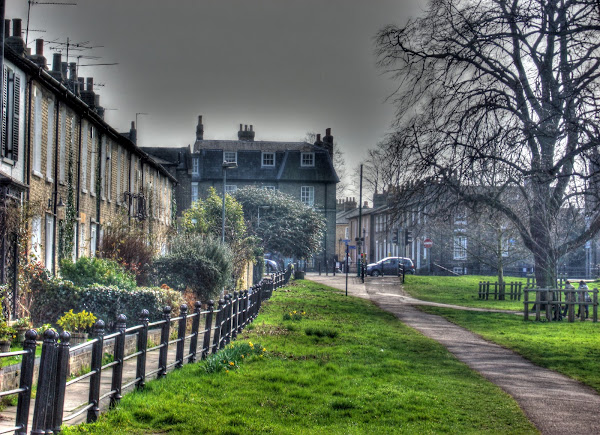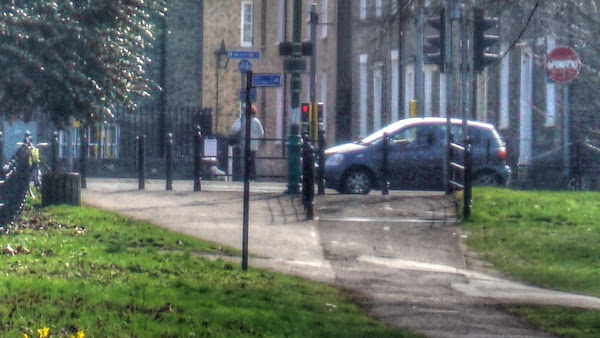Wednesday, 14th March 2012: I had a slightly later start this morning and so was able to set of for my cycle into the middle of Cambridge at a more relaxed and warmer hour. So this time I didn’t bother with a jumper but instead word my lightweight rain jacket and a shirt (with trousers etc). I did contemplate wearing shorts and changing when I got to my destination, but I left a little later than planned. I didn’t overheat as much though as I pretty quickly unzipped the jacket. The only snag was as it was waterproof it was a little clammy around my shoulders.
I didn’t have that much time for pictures either – hence only one and it as dark enough for me to use my lights on my return journey. I took this picture or the cycle path just after passing through Midsummer Common and through Butt Green to cross Maids’ Causeway. The row of houses on the left is on Brunswick Walk. From here I was going to cross Maid’s Causeway and head straight (pretty much) through to Regent Street, albeit on a series of roads with different names, pooping out between the University Arms Hotel and Pizza Hut.
If you look closely you will see that the shared-use cycle and footpath more than doubles in width at the point it reached Maids’ Causeway. If you could look even more closely you would see that the the crossing is arranged so that cyclists go to the right and pedestrians to the left – when looking at this picture.
The cycle bit even divides into two to support two-way cycle traffic. There are to lanes separated by a pole. Each cycle lane passes over a separate cattle grid. The section for pedestrians, to the right has a wide bit for prams, which from memory I think runs over a cattle grid and then two narrower paths without a cattle grid. I guess cattle are to wide to pass the narrow bit.
How do I know this, well I suppose I have inferred that is what the designers thought when they built it. here are a bunch of Cyclestreets pictures although if you look closely at the first picture in the set you will see that the cyclists also seem to wear orange stripes on their faces. It is a good picture of how the crossing looks from Fair Street though.
It also turns out that 8.38 is the time motorists are most at risk of hitting pedestrians. Why? Well apparently it is because one in ten are more attentive to their phones and portable music players. Apparently the AA refer to such practitioners as “podestrians”. Now I have two concerns here – one is that there seems to be a “crackdown” on listening to MP3 players and using Smartphones as if that was wrong? Why is it wrong – for most people they have such a crappy commute that they need the distraction. To be fair I often think how pleasant it is to be able to cycle alongside the River Cam on my way to a meeting and I still listen to my MP3 player.
Let’s face it we tend to be time poor in modern society, I often listen to interesting and educational podcasts. When I took this picture I was listening to a documentary in the Analysis series on Radio 4 – Profits Before Pay”. So are we really saying that all the non-car users must walk and cycle in a soulless fashion, no music, no networking no talking. Has the world gone so wrong that in the name of safety we consider it acceptable that the cars should dictate the minutiae of our lives. As a car driver and a pedestrian and a cyclists I would much prefer to see more emphasis on safety through the design of the road networks.
So I was a little bit later than planned and as I reached this crossing two students were in front of me, one blocking each cycle lane. Did I ting my bell I annoyance, did I huff and puff. No – it wasn’t there fault and in any case they were more vulnerable than me in this particular encounter. The problem lies with the design and layout. I am sure the apologists would claim that given the way roads and streets are it is impossible to do better. Well all I can say to that is it is a load of b*ll*cks. We just choose to marginalise cycling as an activity – which is why we don’t worry about lumping cyclists and pedestrians together.
Once I was at my meeting some of us were discussing how we got there. Apparently one of the car parks is closed for deep-cleaning at the moment (Queen Anne Terrace). Others had used park and ride. I mentioned that I cycled via Riverside and the Cam. The immediate presumption was that I chose that route because it was safer than taking to the roads. No, I pointed out that despite being knocked off my bicycle by an errant motorist a few years ago (broken collar bone) I choose my routes based upon how pleasurable they are to cycle not on how safe I feel – well most of the time anyway.
There was even more consternation that I was going to be cycling home in the dark – isn’t that even more dangerous? What about those cyclists without lights they asked. I showed them my lights – powerful and flexible – they have three different strengths – town, country and bridleway. I also pointed out that despite getting older in Cambridge even cyclists without lights are well illuminated by the streetlights and passing cars. (I am not defending them, just saying.) Actually the worst places to meat un-lit cyclists are on unlit cycle routes – such as the CGB Cycleway or in the middle of Midsummer Common.
The trouble is I am seen as eccentric for cycling and yet there is nothing like a bit of fresh air after being stuck indoors all day. Mind you I can also see how a recent news item “Most dangerous junctions for cyclists (in Cambridge) revealed” probably fuels those fears about the safety and cycling. The data does cover 5 years though and whilst cycling should and could be safer – it ain’t that dangerous and the benefits outweigh the risks.
I do believe that the danger needs to be reduced at source though – for an eloquent discourse on that point – “Campaign season for the safety of cyclists – who cares if cycling is dangerous?" Although the former Cambridge mayor Baroness Trumpington is perhaps best avoided when her husband is driving if you want to stay safe.
On a related topic something I find hazardous are potholes, often they are found were cyclists are “expected” to be. Damage to roads increase steeply with axle weight (to the fourth power apparently). Yet the trend seems to be for cars to get heavier and also for lorries to get heavier. The response is often to patch potholes – but that can be a waste of money and we already have an Eight year road repair backlog here in the East of England.
Which makes me think that we need a shift away from the heavy traffic towards the lighter forms of transport. Unfortunately even buses are not that road friendly since they gather many people and then transmit their weight through only two axles (and so the power law means significantly more road damage per person transported).
Almost finally some public messages – there is to be a crackdown on illegal number plates in the flatlands. Meanwhile the metal theft crackdown is working with arrests being made.
And finally – this is what the King’s Cross Station is looking like and Iceland has a Giant’s Causeway.



No comments:
Post a Comment